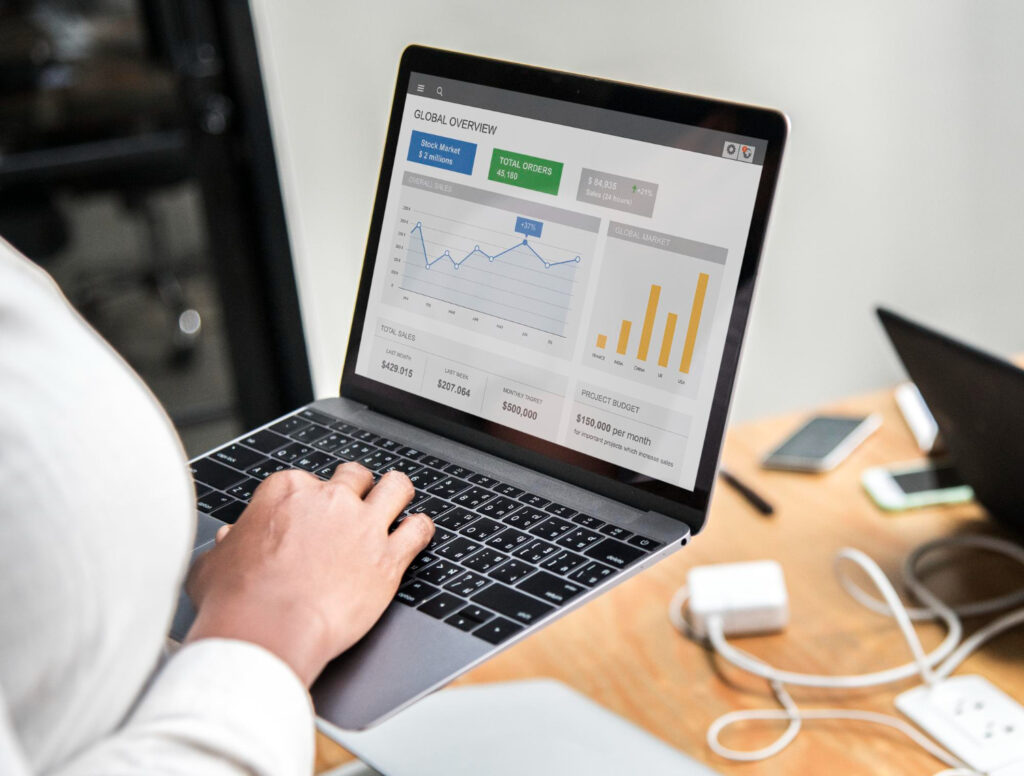Google just changed the rules again. The search giant’s latest algorithm update has websites rising and falling in rankings, leaving many business owners wondering what happened and how to adapt.
These updates aren’t just technical curiosities—they directly impact your website’s visibility and your business’s bottom line. While Google makes hundreds of small tweaks throughout the year, major updates like this one reshape the entire SEO landscape.
What makes this particular update significant is how it reinforces certain ranking signals while diminishing others. The good news? Once you understand what Google is prioritizing now, you can adjust your strategy accordingly.
In this guide, we’ll cut through the confusion to explain what’s changed, how to determine if your site was affected, and most importantly, the specific steps you can take to improve or maintain your rankings under these new conditions.
Let’s decode Google’s latest move and turn it into an opportunity for your business!

Understanding the latest Google algorithm update
Google rolled out its March 2025 Core Update on March 13th, marking the first major algorithm adjustment of the year. According to Google’s announcement, this was “a regular update designed to better surface relevant, satisfying content for searchers from all types of sites.” The update took an unusually long time to complete, running for 14 days until finally concluding on March 27, 2025.
This core update follows several others from the previous year, including the December 2024 Core Update (December 12-18, 2024) and the November 2024 Core Update (November 11-December 5, 2024).
AI content evaluation
A notable aspect of this update appears to be Google’s evolving approach to AI-generated content. Based on early observations from SEO professionals, the March 2025 update shows more nuanced evaluation of AI content:
- Content created with AI tools but substantially edited, enhanced, and fact-checked by humans seems to be performing well
- “Raw” AI-generated content with minimal human oversight continues to decline
- Google appears to be evaluating the purpose and quality of the content rather than simply detecting AI usage
- Sites using AI responsibly to create genuinely helpful content are not being systematically downranked
Historical context
This core update represents a continuation of Google’s ongoing efforts to improve search quality. According to reports from industry experts, “Health and finance sites saw the biggest drops” following the update, with some pages dropping “10+ spots overnight.”
SEO strategist Lily Ray highlighted one significant trend: after approximately 18 months of heightened visibility for forum websites following Google’s mid-2023 “hidden gems” update, many forum sites are now experiencing substantial drops in visibility. While Reddit continues to gain visibility, many other forum sites that benefited from the 2023 algorithm changes are now seeing diminished rankings.
Initial observations

Since the update’s completion, several clear patterns have emerged:
- Forum content devaluation: While Reddit remains strong, other forums are seeing their previously gained visibility disappear
- Programmatic content penalties: Sites creating large volumes of programmatic pages, particularly those designed specifically for SEO rather than user value, appear to be facing penalties
- Websites with strong E-E-A-T (Experience, Expertise, Authoritativeness, and Trustworthiness), real experience, and tight on-page structure appear to be safer or even gaining traffic
- Content quality and relevance are being prioritized, with sites featuring weak or outdated content dropping in rankings
Interestingly, the impacts of the March update have continued to be felt throughout April, with significant ranking volatility observed on April 2, April 9-10, and again on April 15-16, 2025. While Google didn’t announce new updates during this period, many SEO professionals have described these as “aftershocks” from the March core update.
Key Changes in Ranking Factors
The March 2025 Core Update has introduced several notable shifts in how Google evaluates and ranks content. By analyzing website performance data across various industries, SEO professionals have identified key ranking factors that appear to carry more weight in this update:
Content quality factors
Google’s renewed emphasis on experience, expertise, authoritativeness, and trustworthiness (E-E-A-T) has become more pronounced. Sites demonstrating genuine expertise through detailed, well-researched content are seeing positive movement. The update seems to reward:
- First-hand experience and original insights over generic, readily available information
- In-depth coverage with substantive, factual content that thoroughly addresses user queries
- Content created by demonstrable subject-matter experts, especially in YMYL (Your Money, Your Life) topics
- Clear citations, references, and attribution of sources
Technical SEO considerations
While content quality remains paramount, technical factors continue to play a crucial role in rankings:
- Core Web Vitals metrics still matter, particularly Largest Contentful Paint (LCP) and Cumulative Layout Shift (CLS)
- Mobile-first indexing penalties appear stricter, with poorly optimized mobile experiences seeing sharper drops
- Page indexing efficiency has gained importance, with properly structured sites benefiting from faster, more complete indexing
- Schema markup implementation correlates with better performance for sites that use it appropriately
User experience signals
This update has reinforced Google’s commitment to prioritizing sites that deliver superior user experiences:
- Pages with excessive ads above the fold or intrusive interstitials have seen significant ranking drops
- Content accessibility factors, including readable text sizes and navigation clarity, appear more influential
- Sites with clear, logical information architecture are outperforming those with confusing navigation paths
- Page speed metrics continue to correlate with ranking improvements, especially for mobile users
AI and programmatic content evaluation
Perhaps the most notable change relates to how Google assesses AI-generated and programmatic content:
- Content that appears mass-produced or template-based without adding unique value is seeing devaluation
- AI-generated content with human editing, fact-checking, and enhancement is performing better than raw AI output
- Sites relying on programmatic SEO tactics (generating thousands of similar pages with minimal unique content) are experiencing significant visibility losses
- Content that explicitly addresses user intent with substantive information appears prioritized over thin content optimized solely for keywords
These ranking factor changes align with Google’s stated goal of “better surfacing relevant, satisfying content for searchers,” suggesting that sites focused on delivering genuine value to users rather than gaming the algorithm will continue to perform well in the evolving search landscape.
Winners and Losers Analysis
The March 2025 Core Update has created distinct patterns of winners and losers across the digital landscape. Understanding which sites have benefited versus those that have suffered can provide valuable insights into Google’s current priorities.
Who’s seeing improvements?

Several types of websites have experienced notable ranking gains following the update:
- Content-rich authority sites: Established domains with comprehensive coverage of their core topics and strong E-E-A-T signals have seen significant visibility increases. These sites typically offer depth, originality, and demonstrable expertise.
- Reddit and select forum platforms: While many forum sites have declined, Reddit continues its upward trajectory in search visibility. Its combination of active moderation, diverse user-generated content, and frequent updates appears to align with Google’s quality metrics.
- Original content creators: Sites producing unique, first-hand information rather than aggregating or rewriting existing content have gained ground. This includes industry experts, journalists, and creators sharing authentic perspectives.
- Technical optimization leaders: Websites that have invested in comprehensive technical SEO, from Core Web Vitals to structured data implementation, have weathered the update better and often seen improvements.
Who’s experiencing drops?
Several categories of websites have suffered notable ranking declines:
- Forum sites (except Reddit): After benefiting from the 2023 “hidden gems” update, many forum sites are now experiencing substantial visibility drops. SEO strategist Lily Ray noted this trend affects numerous platform-hosted forums.
- AI content factories: Sites publishing large volumes of minimally edited AI-generated content have seen sharp declines. The update appears to better identify and devalue content created primarily through automation without significant human oversight.
- Programmatic SEO sites: Websites using programmatic approaches to create thousands of similar pages (like location-based service pages with minimal unique content) are among the hardest hit.
- Health and finance sites with weak E-E-A-T: YMYL (Your Money, Your Life) sites lacking strong expertise signals or authoritative credentials have experienced particularly severe drops, with some pages falling “10+ spots overnight.”
Industry-specific impacts
The update’s effects have varied significantly across different sectors:
- Health and medical information: Sites without clear medical expertise or professional credentials have seen dramatic ranking declines, while established medical institutions and verified expert content have generally improved.
- Financial services and advice: Similar to health, financial information sites without strong expertise signals have suffered, while established financial institutions and certified professionals have gained visibility.
- E-commerce: Online retailers have experienced mixed results, with those offering detailed product information, original photography, and comprehensive specifications generally outperforming those with thin product pages.
- News and media: Publications demonstrating original reporting and journalistic standards have typically gained ground, while aggregators and sites with minimal original content have declined.
The clear pattern emerging from this update suggests Google is increasingly capable of distinguishing between content created primarily for search engines versus content designed to provide genuine value to users. Sites focusing on the latter appear positioned for long-term success in the evolving search ecosystem.
How to determine if your site was affected
Identifying whether the March 2025 Core Update impacted your website requires a systematic approach to data analysis. By examining specific metrics and patterns, you can determine not only if your site was affected but also how significantly and in which direction.
Diagnostic process
Follow these steps to accurately assess the update’s impact on your website:
- Compare traffic patterns: Look for significant changes in organic traffic that coincide with the update period (March 13-27, 2025). Pay particular attention to any sharp drops or increases around these dates and the subsequent volatility periods in early April.
- Analyze Google Search Console data: Check the “Performance” report and compare the two-week period before the update with the two weeks after. Look for changes in clicks, impressions, average position, and CTR. Filter by query, page, and country to identify specific areas of impact.
- Examine keyword position changes: Use ranking tracking tools to identify which keywords gained or lost positions. Group keywords by intent, volume, and page type to spot patterns in the changes.
- Segment traffic by page type: Determine if certain types of content (product pages, blog posts, category pages) were disproportionately affected, which can provide clues about what aspects of your site the update targeted.
- Compare device performance: Check if mobile and desktop traffic were affected differently, as some updates impact these experiences differently.
Timeline considerations
Understanding the typical timeline of algorithm update effects can help contextualize your findings:
- Initial impact typically appears within 2-3 days of the update’s start
- Full effects often take 1-2 weeks to fully manifest as Google recrawls and reindexes your site
- Secondary waves of volatility have been observed with this update (April 2, 9-10, and 15-16), so continued monitoring is necessary
- Differentiating between normal fluctuations and update impacts requires looking for sustained changes rather than daily variations
Helpful tools
Several tools can assist in your analysis:
- Google Search Console: Essential for examining organic search performance metrics directly from Google’s data
- Google Analytics: For measuring the business impact of any traffic changes
- Rank tracking tools: Services like Semrush, Ahrefs, or Moz offer detailed position tracking and SERP analysis
- Algorithm update trackers: Tools like Semrush Sensor or Mozcast that measure daily volatility in search results
- Competitor analysis tools: To determine if changes are affecting your entire industry or just your site
When analyzing your data, remember that correlation doesn’t always indicate causation. Look for multiple data points that align with the update timeline before concluding that any changes were definitely caused by the algorithm update rather than by other factors such as seasonality, technical issues, or content changes on your site.
If your analysis confirms that your site was impacted by the update, the next step is to develop a strategic response based on the specific patterns observed in your data and the known focus areas of this update.
Action plan for recovery or optimization
Whether your site experienced a ranking drop or you’re proactively optimizing for the new algorithm landscape, the following strategic approaches can help you align with Google’s current ranking priorities.
Content strategy adjustments
The March 2025 update continues Google’s emphasis on high-quality, valuable content:
- Conduct a comprehensive content audit: Identify underperforming pages and categorize them for improvement, consolidation, or removal. Pay special attention to pages with significant traffic changes since the update.
- Enhance E-E-A-T signals: Strengthen your expertise, experience, authoritativeness, and trustworthiness by adding author credentials, citing reputable sources, updating outdated information, and incorporating first-hand experience and original insights.
- Address thin content issues: Prioritize pages with minimal unique value, particularly those created through templated or programmatic approaches. Either significantly enhance these pages or consider consolidating or removing them.
- Improve content depth: Ensure your content comprehensively addresses user intent rather than merely targeting keywords. Expand coverage on topics central to your site’s expertise and prune peripheral content that dilutes your topical authority.
- Review AI-generated content: If you use AI writing tools, implement a robust human editing process to add original insights, verify facts, and ensure the content provides unique value beyond what AI alone can produce.
Technical fixes
Technical optimization remains crucial for recovery and continued performance:
- Core Web Vitals optimization: Address any metrics that fall below Google’s “good” thresholds, particularly Largest Contentful Paint, First Input Delay, and Cumulative Layout Shift. The Google Page Speed Insights tool offers specific recommendations.
- Mobile experience enhancement: Ensure your mobile site offers a seamless experience, as Google’s mobile-first indexing appears to have stricter quality thresholds in this update.
- Indexing efficiency: Resolve crawling and indexing issues by optimizing your site architecture, internal linking, and XML sitemaps. Check for crawl errors or coverage issues in Google Search Console.
- Schema markup implementation: Add appropriate structured data to help Google better understand your content and potentially enhance your SERP presentation with rich results.
- Site architecture review: Ensure your information architecture logically organizes content, with clear navigation paths and appropriate internal linking that reinforces your topical expertise.
User experience improvements
The update shows Google’s continued focus on superior user experiences:
- Ad placement optimization: If your site uses advertising, review placement and density to ensure ads don’t interfere with content consumption, especially above the fold on mobile devices.
- Interstitial review: Remove or minimize intrusive interstitials that could negatively impact user experience and now appear more heavily penalized.
- Navigation enhancement: Simplify site navigation to help users easily find related content and improve session engagement metrics.
- Page speed improvements: Optimize images, implement lazy loading, leverage browser caching, and minimize render-blocking resources to improve loading times.
- Readability improvements: Ensure content is easily readable on all devices with appropriate font sizes, contrast ratios, and formatting that enhances comprehension.
Link profile assessment
While content quality dominates this update, link signals remain important:
- Link quality evaluation: Review your backlink profile using tools like Ahrefs or Semrush to identify potentially harmful links that could be triggering algorithmic penalties.
- Disavow toxic links: Consider disavowing links from low-quality or irrelevant sources that could be negatively affecting your site’s authority.
- Internal linking strategy: Strengthen your internal linking structure to better distribute page authority and create clear topical clusters that reinforce your expertise in key areas.
- Earned media opportunities: Develop strategies to attract high-quality, relevant backlinks through content that genuinely warrants citation rather than through artificial link building tactics.
The recovery timeline following these implementations varies depending on crawl frequency and the severity of issues addressed, but many sites begin seeing improvements within 4-8 weeks of making significant changes. Continue monitoring performance metrics and be prepared to adapt your strategy as Google’s algorithm continues to evolve.
Future-proofing your SEO strategy

As Google’s algorithms continue to evolve, developing a resilient SEO approach that withstands future updates becomes increasingly important. Rather than reactively adjusting to each algorithm change, forward-thinking strategies can position your site for long-term success.
Sustainable SEO practices
Focus on these enduring principles that align with Google’s long-term trajectory:
- Prioritize user value over search engines: Create content that genuinely serves user needs rather than attempting to manipulate algorithms. Google’s systems are increasingly sophisticated at identifying content created primarily for search engines versus content designed for users.
- Build genuine topical authority: Rather than spreading thin across numerous topics, develop comprehensive coverage and demonstrable expertise in your core subject areas. The March update reinforced Google’s preference for authoritative sources within specific niches.
- Emphasize original contributions: Prioritize content that adds unique perspectives, original research, or first-hand experience rather than reformulating existing information. Sites offering genuine additions to the internet’s knowledge base consistently outperform content aggregators.
- Integrate robust quality assurance: Implement systematic content review processes that ensure accuracy, comprehensiveness, and currency. Regular content audits and updates should be standard practice rather than reactive measures.
- Balance AI utilization with human expertise: As AI content generation tools become more prevalent, develop frameworks for appropriately leveraging these technologies while ensuring human expertise, creativity, and verification remain central to your content strategy.
Monitoring protocol
Establish proactive monitoring systems to identify potential issues before they significantly impact performance:
- Implement regular health checks: Schedule monthly technical SEO audits to catch emerging issues before they compound. Look for crawl errors, indexing problems, and Core Web Vitals degradation.
- Track algorithm volatility: Use tools like Semrush Sensor or Mozcast to monitor daily search volatility and correlate any significant traffic changes with potential algorithm adjustments.
- Watch for warning signs: Establish early warning systems by monitoring key metrics like organic session duration, pages per session, and bounce rates. Deterioration in these engagement metrics often precedes ranking drops.
- Monitor competitive positioning: Regularly analyze how your site performs against competitors for key terms and topics. Sudden competitive shifts can indicate algorithm changes affecting your industry.
- Set up automated alerts: Configure threshold-based alerts in Google Analytics and Search Console to immediately notify you of significant traffic or ranking changes that warrant investigation.
Staying informed
Keeping current with search evolution requires strategic information sourcing:
- Follow authoritative sources: Rely on official Google communications through the Google Search Central Blog and Search Status Dashboard for definitive update information rather than speculation.
- Engage with the SEO community: Participate in professional forums and social media groups where experienced practitioners share observations and analyses of algorithm changes.
- Study search quality guidelines: Regularly review Google’s publicly available Search Quality Rater Guidelines, which provide insights into how Google defines quality content and what human evaluators look for.
- Track industry experts: Follow recognized SEO analysts like Lily Ray, Marie Haynes, or Google’s own search representatives who frequently share valuable perspectives on algorithm changes.
- Analyze SERP features evolution: Monitor how search results pages themselves are changing, including the integration of AI Overviews, featured snippets, and other SERP features that may affect traditional organic visibility.
By focusing on these sustainable practices and monitoring systems, your site can not only recover from the March 2025 update if negatively affected but also build resilience against future algorithm changes. The core principles of providing exceptional user value, demonstrating genuine expertise, and maintaining technical excellence remain the most reliable foundation for long-term search success.
Final word
The March 2025 Core Update sends a clear message: Google continues to raise the bar for quality, rewarding sites with genuine expertise and penalizing those relying on shortcuts. The winners demonstrate authentic E-E-A-T signals and exceptional user experiences, while programmatic SEO and unedited AI content face increasing scrutiny.
For those affected, recovery requires honest assessment and strategic improvement—not quick fixes. Focus on creating content that provides unique value your competitors can’t easily replicate, optimizing technical performance, and delivering seamless user experiences across devices.
Remember, sustainable SEO isn’t about outsmarting Google but aligning with its core mission: connecting users with truly helpful content. Sites that prioritize audience needs over algorithm manipulation will not only recover from this update but build resilience against future changes in the ever-evolving search landscape.
About Content Authority
At Content Authority, we combine data-driven SEO strategies with content expertise to help businesses achieve sustainable search visibility. Based in the Philippines but serving clients worldwide, our team specializes in algorithm-resilient optimization that withstands Google’s frequent updates while driving meaningful traffic that converts.
Our approach focuses on developing genuine topical authority and creating content that serves real user needs—principles that have helped our clients maintain and grow their rankings through multiple algorithm changes, including the recent March 2025 Core Update. We believe in building search strategies that work for both users and search engines, delivering long-term results rather than temporary gains.
Ready to strengthen your website’s performance in this new search landscape? Contact us to learn how our tailored SEO consulting services can help your business thrive online.


Leave a Reply